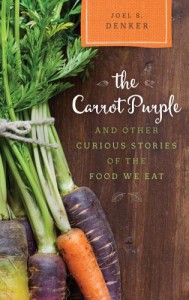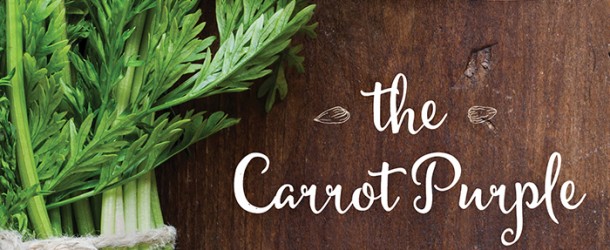 Like any true food geek, I’m fascinated by the origins of what we put on our plates, so when I was offered a review copy of The Carrot Purple and Other Curious Stories of the Food We Eat by Joel S. Denker, I jumped at the opportunity.
Like any true food geek, I’m fascinated by the origins of what we put on our plates, so when I was offered a review copy of The Carrot Purple and Other Curious Stories of the Food We Eat by Joel S. Denker, I jumped at the opportunity.
The Carrot Purple takes a look at many of the foods we are familiar with today and traces their paths from obscurity. From anise to watermelon, each chapter is dedicated to a different plant food, spice, or in the case of coffee and chocolate, beverage, beginning with anise and ending with watermelon. Mr Denker delves not only the culinary significance of each, but also its cultural, ceremonial, medicinal, and economic importance. Certain foods were savored or revered while others were reviled.
The history of the book’s title vegetable is quite fascinating. Purple carrots were once the norm and the orange variety was a novelty. The problem with purple carrots was not their taste, but rather their color. When cooked with other vegetables in soups and stews, the end result was a muddy purplish-brown color. Purple carrots were ditched in favor of yellow ones, and yellow eventually gave way to the orange carrot we know and love today.
It was interesting to read that celery was once favored for its medicinal uses, rather than culinary applications. In fact, Greeks often hung celery in the rooms of people with severe illnesses. Once it became a popular food, vendors began selling it on street corners, and it became a popular railway snack. It was still touted for its health benefits, and reading about the celery craze of the late 1800s reminds me of the kale mania that we’re currently in the midst of.
I already knew that cashews were the seed of a fruit, but I found it quite amusing to learn that some cultures prefer the fruit. In fact, to some, jellies, jams and juices from the fruit are a special treat. I also learned that you’ll never see a cashew still in the shell in the grocery store because the oils inside the shell can cause severe burns to the mouth and lips. Ouch!
I don’t usually give a second thought to most of the foods on my plate, but after reading The Carrot Purple, I now that I know where many of them originated and how they made their way to me. I also realize that had history gone taken a slightly different turn, I might be eating something completely different altogether. I’m really impressed with the research that went into this book, and how much info is packed into each chapter. I highly recommend The Carrot Purple to anyone who likes to read about food, is interested in history, or just likes to learn new facts.
